Xinyu Liu
xGR: Efficient Generative Recommendation Serving at Scale
Dec 19, 2025Abstract:Recommendation system delivers substantial economic benefits by providing personalized predictions. Generative recommendation (GR) integrates LLMs to enhance the understanding of long user-item sequences. Despite employing attention-based architectures, GR's workload differs markedly from that of LLM serving. GR typically processes long prompt while producing short, fixed-length outputs, yet the computational cost of each decode phase is especially high due to the large beam width. In addition, since the beam search involves a vast item space, the sorting overhead becomes particularly time-consuming. We propose xGR, a GR-oriented serving system that meets strict low-latency requirements under highconcurrency scenarios. First, xGR unifies the processing of prefill and decode phases through staged computation and separated KV cache. Second, xGR enables early sorting termination and mask-based item filtering with data structure reuse. Third, xGR reconstructs the overall pipeline to exploit multilevel overlap and multi-stream parallelism. Our experiments with real-world recommendation service datasets demonstrate that xGR achieves at least 3.49x throughput compared to the state-of-the-art baseline under strict latency constraints.
ReViSE: Towards Reason-Informed Video Editing in Unified Models with Self-Reflective Learning
Dec 11, 2025Abstract:Video unified models exhibit strong capabilities in understanding and generation, yet they struggle with reason-informed visual editing even when equipped with powerful internal vision-language models (VLMs). We attribute this gap to two factors: 1) existing datasets are inadequate for training and evaluating reasoning-aware video editing, and 2) an inherent disconnect between the models' reasoning and editing capabilities, which prevents the rich understanding from effectively instructing the editing process. Bridging this gap requires an integrated framework that connects reasoning with visual transformation. To address this gap, we introduce the Reason-Informed Video Editing (RVE) task, which requires reasoning about physical plausibility and causal dynamics during editing. To support systematic evaluation, we construct RVE-Bench, a comprehensive benchmark with two complementary subsets: Reasoning-Informed Video Editing and In-Context Video Generation. These subsets cover diverse reasoning dimensions and real-world editing scenarios. Building upon this foundation, we propose the ReViSE, a Self-Reflective Reasoning (SRF) framework that unifies generation and evaluation within a single architecture. The model's internal VLM provides intrinsic feedback by assessing whether the edited video logically satisfies the given instruction. The differential feedback that refines the generator's reasoning behavior during training. Extensive experiments on RVE-Bench demonstrate that ReViSE significantly enhances editing accuracy and visual fidelity, achieving a 32% improvement of the Overall score in the reasoning-informed video editing subset over state-of-the-art methods.
Content-Adaptive Image Retouching Guided by Attribute-Based Text Representation
Dec 10, 2025Abstract:Image retouching has received significant attention due to its ability to achieve high-quality visual content. Existing approaches mainly rely on uniform pixel-wise color mapping across entire images, neglecting the inherent color variations induced by image content. This limitation hinders existing approaches from achieving adaptive retouching that accommodates both diverse color distributions and user-defined style preferences. To address these challenges, we propose a novel Content-Adaptive image retouching method guided by Attribute-based Text Representation (CA-ATP). Specifically, we propose a content-adaptive curve mapping module, which leverages a series of basis curves to establish multiple color mapping relationships and learns the corresponding weight maps, enabling content-aware color adjustments. The proposed module can capture color diversity within the image content, allowing similar color values to receive distinct transformations based on their spatial context. In addition, we propose an attribute text prediction module that generates text representations from multiple image attributes, which explicitly represent user-defined style preferences. These attribute-based text representations are subsequently integrated with visual features via a multimodal model, providing user-friendly guidance for image retouching. Extensive experiments on several public datasets demonstrate that our method achieves state-of-the-art performance.
CreBench: Human-Aligned Creativity Evaluation from Idea to Process to Product
Nov 17, 2025Abstract:Human-defined creativity is highly abstract, posing a challenge for multimodal large language models (MLLMs) to comprehend and assess creativity that aligns with human judgments. The absence of an existing benchmark further exacerbates this dilemma. To this end, we propose CreBench, which consists of two key components: 1) an evaluation benchmark covering the multiple dimensions from creative idea to process to products; 2) CreMIT (Creativity Multimodal Instruction Tuning dataset), a multimodal creativity evaluation dataset, consisting of 2.2K diverse-sourced multimodal data, 79.2K human feedbacks and 4.7M multi-typed instructions. Specifically, to ensure MLLMs can handle diverse creativity-related queries, we prompt GPT to refine these human feedbacks to activate stronger creativity assessment capabilities. CreBench serves as a foundation for building MLLMs that understand human-aligned creativity. Based on the CreBench, we fine-tune open-source general MLLMs, resulting in CreExpert, a multimodal creativity evaluation expert model. Extensive experiments demonstrate that the proposed CreExpert models achieve significantly better alignment with human creativity evaluation compared to state-of-the-art MLLMs, including the most advanced GPT-4V and Gemini-Pro-Vision.
Persona-Aware Alignment Framework for Personalized Dialogue Generation
Nov 13, 2025Abstract:Personalized dialogue generation aims to leverage persona profiles and dialogue history to generate persona-relevant and consistent responses. Mainstream models typically rely on token-level language model training with persona dialogue data, such as Next Token Prediction, to implicitly achieve personalization, making these methods tend to neglect the given personas and generate generic responses. To address this issue, we propose a novel Persona-Aware Alignment Framework (PAL), which directly treats persona alignment as the training objective of dialogue generation. Specifically, PAL employs a two-stage training method including Persona-aware Learning and Persona Alignment, equipped with an easy-to-use inference strategy Select then Generate, to improve persona sensitivity and generate more persona-relevant responses at the semantics level. Through extensive experiments, we demonstrate that our framework outperforms many state-of-the-art personalized dialogue methods and large language models.
Extensions of Robbins-Siegmund Theorem with Applications in Reinforcement Learning
Sep 30, 2025Abstract:The Robbins-Siegmund theorem establishes the convergence of stochastic processes that are almost supermartingales and is foundational for analyzing a wide range of stochastic iterative algorithms in stochastic approximation and reinforcement learning (RL). However, its original form has a significant limitation as it requires the zero-order term to be summable. In many important RL applications, this summable condition, however, cannot be met. This limitation motivates us to extend the Robbins-Siegmund theorem for almost supermartingales where the zero-order term is not summable but only square summable. Particularly, we introduce a novel and mild assumption on the increments of the stochastic processes. This together with the square summable condition enables an almost sure convergence to a bounded set. Additionally, we further provide almost sure convergence rates, high probability concentration bounds, and $L^p$ convergence rates. We then apply the new results in stochastic approximation and RL. Notably, we obtain the first almost sure convergence rate, the first high probability concentration bound, and the first $L^p$ convergence rate for $Q$-learning with linear function approximation.
IIET: Efficient Numerical Transformer via Implicit Iterative Euler Method
Sep 26, 2025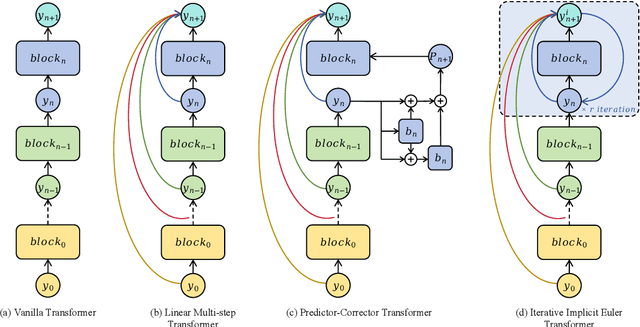
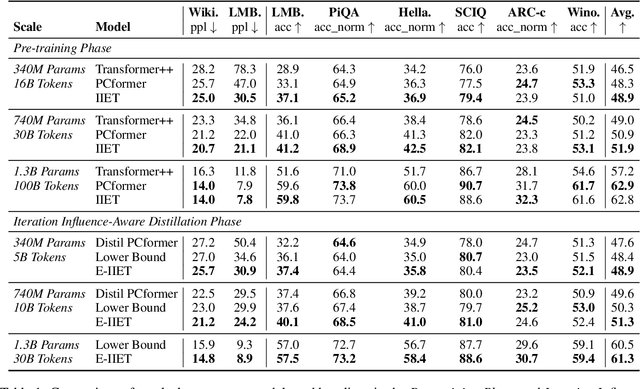
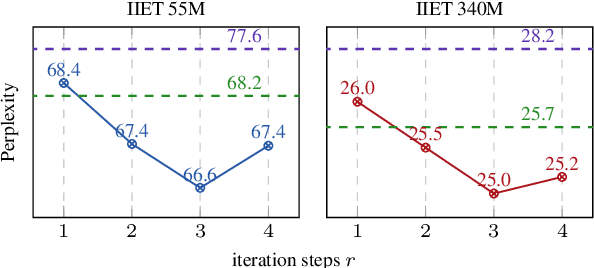

Abstract:High-order numerical methods enhance Transformer performance in tasks like NLP and CV, but introduce a performance-efficiency trade-off due to increased computational overhead. Our analysis reveals that conventional efficiency techniques, such as distillation, can be detrimental to the performance of these models, exemplified by PCformer. To explore more optimizable ODE-based Transformer architectures, we propose the \textbf{I}terative \textbf{I}mplicit \textbf{E}uler \textbf{T}ransformer \textbf{(IIET)}, which simplifies high-order methods using an iterative implicit Euler approach. This simplification not only leads to superior performance but also facilitates model compression compared to PCformer. To enhance inference efficiency, we introduce \textbf{I}teration \textbf{I}nfluence-\textbf{A}ware \textbf{D}istillation \textbf{(IIAD)}. Through a flexible threshold, IIAD allows users to effectively balance the performance-efficiency trade-off. On lm-evaluation-harness, IIET boosts average accuracy by 2.65\% over vanilla Transformers and 0.8\% over PCformer. Its efficient variant, E-IIET, significantly cuts inference overhead by 55\% while retaining 99.4\% of the original task accuracy. Moreover, the most efficient IIET variant achieves an average performance gain exceeding 1.6\% over vanilla Transformer with comparable speed.
TCPO: Thought-Centric Preference Optimization for Effective Embodied Decision-making
Sep 10, 2025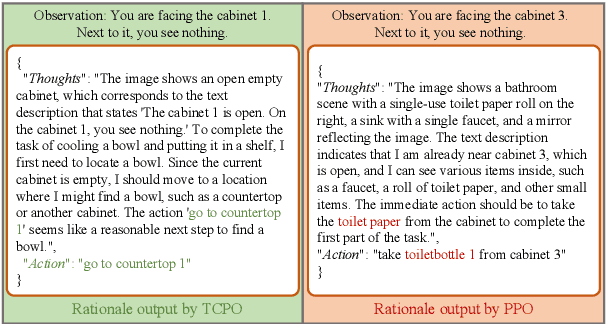

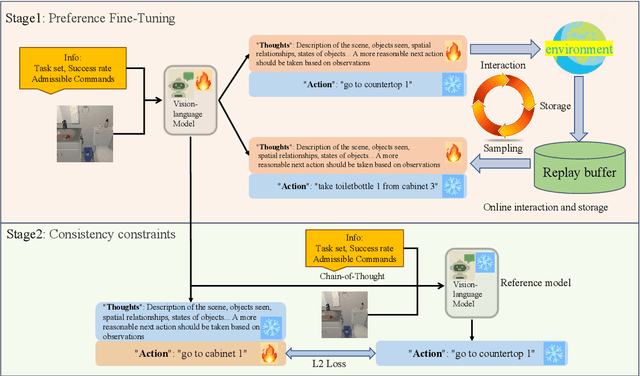

Abstract:Using effective generalization capabilities of vision language models (VLMs) in context-specific dynamic tasks for embodied artificial intelligence remains a significant challenge. Although supervised fine-tuned models can better align with the real physical world, they still exhibit sluggish responses and hallucination issues in dynamically changing environments, necessitating further alignment. Existing post-SFT methods, reliant on reinforcement learning and chain-of-thought (CoT) approaches, are constrained by sparse rewards and action-only optimization, resulting in low sample efficiency, poor consistency, and model degradation. To address these issues, this paper proposes Thought-Centric Preference Optimization (TCPO) for effective embodied decision-making. Specifically, TCPO introduces a stepwise preference-based optimization approach, transforming sparse reward signals into richer step sample pairs. It emphasizes the alignment of the model's intermediate reasoning process, mitigating the problem of model degradation. Moreover, by incorporating Action Policy Consistency Constraint (APC), it further imposes consistency constraints on the model output. Experiments in the ALFWorld environment demonstrate an average success rate of 26.67%, achieving a 6% improvement over RL4VLM and validating the effectiveness of our approach in mitigating model degradation after fine-tuning. These results highlight the potential of integrating preference-based learning techniques with CoT processes to enhance the decision-making capabilities of vision-language models in embodied agents.
FusionCounting: Robust visible-infrared image fusion guided by crowd counting via multi-task learning
Aug 28, 2025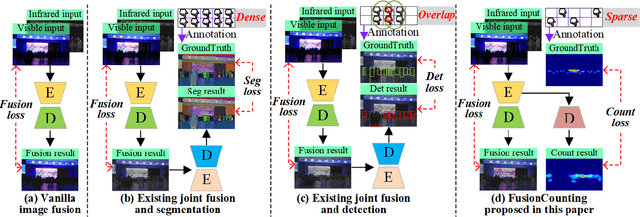

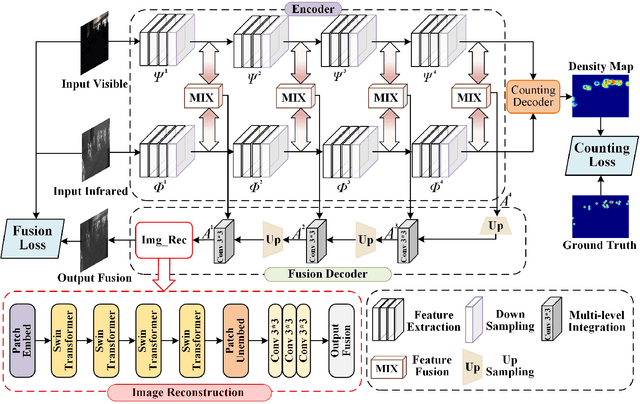

Abstract:Most visible and infrared image fusion (VIF) methods focus primarily on optimizing fused image quality. Recent studies have begun incorporating downstream tasks, such as semantic segmentation and object detection, to provide semantic guidance for VIF. However, semantic segmentation requires extensive annotations, while object detection, despite reducing annotation efforts compared with segmentation, faces challenges in highly crowded scenes due to overlapping bounding boxes and occlusion. Moreover, although RGB-T crowd counting has gained increasing attention in recent years, no studies have integrated VIF and crowd counting into a unified framework. To address these challenges, we propose FusionCounting, a novel multi-task learning framework that integrates crowd counting into the VIF process. Crowd counting provides a direct quantitative measure of population density with minimal annotation, making it particularly suitable for dense scenes. Our framework leverages both input images and population density information in a mutually beneficial multi-task design. To accelerate convergence and balance tasks contributions, we introduce a dynamic loss function weighting strategy. Furthermore, we incorporate adversarial training to enhance the robustness of both VIF and crowd counting, improving the model's stability and resilience to adversarial attacks. Experimental results on public datasets demonstrate that FusionCounting not only enhances image fusion quality but also achieves superior crowd counting performance.
aiXiv: A Next-Generation Open Access Ecosystem for Scientific Discovery Generated by AI Scientists
Aug 20, 2025Abstract:Recent advances in large language models (LLMs) have enabled AI agents to autonomously generate scientific proposals, conduct experiments, author papers, and perform peer reviews. Yet this flood of AI-generated research content collides with a fragmented and largely closed publication ecosystem. Traditional journals and conferences rely on human peer review, making them difficult to scale and often reluctant to accept AI-generated research content; existing preprint servers (e.g. arXiv) lack rigorous quality-control mechanisms. Consequently, a significant amount of high-quality AI-generated research lacks appropriate venues for dissemination, hindering its potential to advance scientific progress. To address these challenges, we introduce aiXiv, a next-generation open-access platform for human and AI scientists. Its multi-agent architecture allows research proposals and papers to be submitted, reviewed, and iteratively refined by both human and AI scientists. It also provides API and MCP interfaces that enable seamless integration of heterogeneous human and AI scientists, creating a scalable and extensible ecosystem for autonomous scientific discovery. Through extensive experiments, we demonstrate that aiXiv is a reliable and robust platform that significantly enhances the quality of AI-generated research proposals and papers after iterative revising and reviewing on aiXiv. Our work lays the groundwork for a next-generation open-access ecosystem for AI scientists, accelerating the publication and dissemination of high-quality AI-generated research content. Code is available at https://github.com/aixiv-org. Website is available at https://forms.gle/DxQgCtXFsJ4paMtn8.
 Add to Chrome
Add to Chrome Add to Firefox
Add to Firefox Add to Edge
Add to Edge